british
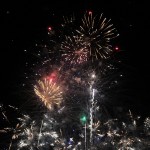 I think that one of the things most people look forward to in mid-summer is Independence Day. Of course, the normal holiday for many people is filled with picnics, fireworks, and celebration of our freedom. Many of us consider the price that was paid in the Revolutionary War to win our freedom from England, and then our thoughts move on to the many wars the United Stares has fought into keep our freedoms, and to win freedom for oppressed nations around the world. It’s a noble thing our soldiers do, often with little thanks from those they help. And all too often, their work is quickly forgotten or even protested by those who do not understand how important it is not to give away our freedoms to those who do not share our values.
I think that one of the things most people look forward to in mid-summer is Independence Day. Of course, the normal holiday for many people is filled with picnics, fireworks, and celebration of our freedom. Many of us consider the price that was paid in the Revolutionary War to win our freedom from England, and then our thoughts move on to the many wars the United Stares has fought into keep our freedoms, and to win freedom for oppressed nations around the world. It’s a noble thing our soldiers do, often with little thanks from those they help. And all too often, their work is quickly forgotten or even protested by those who do not understand how important it is not to give away our freedoms to those who do not share our values.
Whatever a person’s politics are, or even if they don’t participate at all, pretty much  everyone celebrates Independence Day. It is a beloved holiday in this country. It’s a day to celebrate who we are as a nation….the land of the free, and the home of the brave. The fireworks are to remember the rockets that were used in the battle for our independence. The patriot soldiers fought hard against the British, never giving up, even if they lost their lives in the battle. The danger was worth the risk. They could no longer be slaves to the British. They were being taxed without representation, and unmercifully. It was time for the United States to become it’s own nation. I don’t think the British have any inkling that they would lose the Revolutionary War. It was like being beaten by your child. How could that “kid” actually have grown enough to beat them…and yet, the “kid” had not only fought against the “parent” country, but they won. They fought and now we’re free!!
everyone celebrates Independence Day. It is a beloved holiday in this country. It’s a day to celebrate who we are as a nation….the land of the free, and the home of the brave. The fireworks are to remember the rockets that were used in the battle for our independence. The patriot soldiers fought hard against the British, never giving up, even if they lost their lives in the battle. The danger was worth the risk. They could no longer be slaves to the British. They were being taxed without representation, and unmercifully. It was time for the United States to become it’s own nation. I don’t think the British have any inkling that they would lose the Revolutionary War. It was like being beaten by your child. How could that “kid” actually have grown enough to beat them…and yet, the “kid” had not only fought against the “parent” country, but they won. They fought and now we’re free!!

Since they won, we have something wonderful to celebrate on July 4th…our independence. When I think of the alternative, I cringe. It’s not that I hate England, because, in fact, I don’t. I have relatives there, including in the royal family, so I don’t hate England, but we were just different. Our values and ideals were different. We could not peacefully co-exist the way we were, And yet, now that we are two separate nations, we are allies. We had to be equals in order to be allies. We had to have their respect, as a free nation, and we got it. We have been a respected, free nation since that day…July 4, 1776. And that is why we still celebrate our independence. Happy Independence Day everyone!!
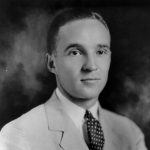
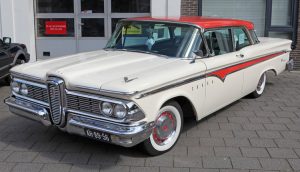 Despite having a domineering father, who was never pleased with anything he did, Edsel Ford, the son of the founder of Ford Motors is mainly remembered for the Edsel, a failed 1958-60 car model. In reality, he was one of the masterminds of the Allied victory in World War II. Against the wishes of his father, Edsel Ford telephones William Knudsen of the U.S. Office of Production Management on June 12, 1940, to confirm Ford Motor Company’s acceptance of Knudsen’s proposal to manufacture 9,000 Rolls-Royce-designed engines to be used in British and United States airplanes. In all, they would build, 9,000 B-24 Liberator bombers, 278,000 Jeeps, 93,000 military trucks, 12,000 armored cars, 3,000 tanks, and 27,000 tank engines, but it was not without a few stumbling blocks. Edsel and Charles Sorensen, Ford’s production chief, had apparently gotten the go-ahead from Henry Ford by June 12, when Edsel telephoned Knudsen to confirm that Ford would produce 9,000 Rolls-Royce Merlin airplane engines (6,000 for the RAF and 3,000 for the U.S. Army). However, as soon as the British press announced the deal, Henry Ford personally and publicly canceled it, telling a reporter: “We are not doing business with the British government or any other government.”
Despite having a domineering father, who was never pleased with anything he did, Edsel Ford, the son of the founder of Ford Motors is mainly remembered for the Edsel, a failed 1958-60 car model. In reality, he was one of the masterminds of the Allied victory in World War II. Against the wishes of his father, Edsel Ford telephones William Knudsen of the U.S. Office of Production Management on June 12, 1940, to confirm Ford Motor Company’s acceptance of Knudsen’s proposal to manufacture 9,000 Rolls-Royce-designed engines to be used in British and United States airplanes. In all, they would build, 9,000 B-24 Liberator bombers, 278,000 Jeeps, 93,000 military trucks, 12,000 armored cars, 3,000 tanks, and 27,000 tank engines, but it was not without a few stumbling blocks. Edsel and Charles Sorensen, Ford’s production chief, had apparently gotten the go-ahead from Henry Ford by June 12, when Edsel telephoned Knudsen to confirm that Ford would produce 9,000 Rolls-Royce Merlin airplane engines (6,000 for the RAF and 3,000 for the U.S. Army). However, as soon as the British press announced the deal, Henry Ford personally and publicly canceled it, telling a reporter: “We are not doing business with the British government or any other government.”
Unlike other automakers, Ford had already built a successful airplane in the 1920s called the Tri-Motor. That fact made them the logical choice when the war effort needed more planes. In two meetings in late May and early June 1940, Knudsen and Edsel Ford agreed that Ford would manufacture the new fleet of aircraft for the RAF on an expedited basis. The one significant obstacle was Edsel’s father Henry Ford, who still retained complete control over the company he founded, even though he had turned the figurehead control over to his son. Henry Ford was well known for his opposition to the possible U.S. entry into World War II, so it would be up to Edsel to convince him that it was necessary.
According to Douglas Brinkley’s biography of Ford, “Wheels for the World,” Henry Ford had in effect already accepted a contract from the German government. The Ford subsidiary Ford-Werke in Cologne was doing business with the Third Reich at the time, which Ford’s critics took as proof that he was concealing a pro-German bias behind his claims to be a man of peace. Nevertheless, as U.S. entry into the war became more of 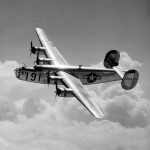
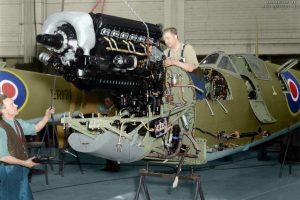 a certainty, Ford reversed his position, and the company opened a large new government-sponsored facility at Willow Run, Michigan in May of 1941, for the purposes of manufacturing the B-24E Liberator bombers for the Allied war effort. Ford Motor plants also produced a great deal of other war materiel during World War II, including a variety of engines, trucks, jeeps, tanks and tank destroyers. The production needs met by Ford Motor Company during World War II were instrumental in the Allied victory in that war.
a certainty, Ford reversed his position, and the company opened a large new government-sponsored facility at Willow Run, Michigan in May of 1941, for the purposes of manufacturing the B-24E Liberator bombers for the Allied war effort. Ford Motor plants also produced a great deal of other war materiel during World War II, including a variety of engines, trucks, jeeps, tanks and tank destroyers. The production needs met by Ford Motor Company during World War II were instrumental in the Allied victory in that war.
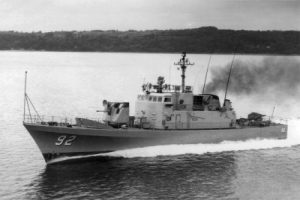 Would you want your nation to go to war over fish? Would you even consider that nations might do that? Well, enter the Cod Wars. The Cod Wars were disputes over Iceland’s territorial waters, fought in four bouts over a 25 year period: The Proto Cod War, between 1952 and 1956; the First Cod War between 1958 and 1961; the Second Cod War between 1972 and 1973; and the Third Cod War between 1975 and 1976. Iceland wanted to expand its territorial waters and exclude foreign fishing fleets. Britain would have none of that. The British distant fishing fleet fished extensively in the waters off Iceland, and supplied a lot of fish and chips shops. But Britain also wanted to prevent precedents that violated the principle of narrow territorial waters. Narrow territorial waters were key for the Royal Navy to sail freely and continue to project power across the world. The Icelanders were motivated by the prospective economic gains. An extension of its territorial waters meant greater catches, and a way to exclude competing trawler fleets and conserve important fishing grounds. The country’s heavy dependence on fishing meant that extensions had a significant impact on Iceland’s Gross Domestic Product, roughly one-quarter of which was tied to the fisheries sector, export earnings one-half to two-thirds of which were tied to the fisheries sector and employment roughly 15 percent of which was in the fisheries sector.
Would you want your nation to go to war over fish? Would you even consider that nations might do that? Well, enter the Cod Wars. The Cod Wars were disputes over Iceland’s territorial waters, fought in four bouts over a 25 year period: The Proto Cod War, between 1952 and 1956; the First Cod War between 1958 and 1961; the Second Cod War between 1972 and 1973; and the Third Cod War between 1975 and 1976. Iceland wanted to expand its territorial waters and exclude foreign fishing fleets. Britain would have none of that. The British distant fishing fleet fished extensively in the waters off Iceland, and supplied a lot of fish and chips shops. But Britain also wanted to prevent precedents that violated the principle of narrow territorial waters. Narrow territorial waters were key for the Royal Navy to sail freely and continue to project power across the world. The Icelanders were motivated by the prospective economic gains. An extension of its territorial waters meant greater catches, and a way to exclude competing trawler fleets and conserve important fishing grounds. The country’s heavy dependence on fishing meant that extensions had a significant impact on Iceland’s Gross Domestic Product, roughly one-quarter of which was tied to the fisheries sector, export earnings one-half to two-thirds of which were tied to the fisheries sector and employment roughly 15 percent of which was in the fisheries sector.
Each Cod War broke out when Iceland extended its territorial waters and the British failed to comply with the new Icelandic regulations. Clashes and confrontations started between Icelandic patrol ships and British trawlers. The harassment of British trawlers in the contested waters provoked the British to sanction the Icelanders in the Proto Cod War preventing the Icelanders from accessing their largest export market and send the Royal Navy into the contested waters during the last three Cod Wars. Neither side actively tried to cause casualties but the clashes at sea were still dangerous. I can’t imagine a war, in which the combatants try not to 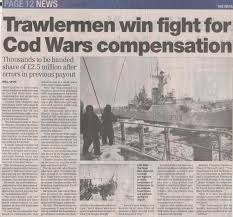 hurt each other. Nevertheless, individuals were injured, and there was one fatality on the Icelandic side. Surely bargaining would have saved both sides the inevitable costs and risks of unilateral, unrecognized expansions. Historians and political scientists have identified how domestic pressure on elites and the nature of alliance politics contributed to miscalculation on both sides that contributed to bargaining failure.
hurt each other. Nevertheless, individuals were injured, and there was one fatality on the Icelandic side. Surely bargaining would have saved both sides the inevitable costs and risks of unilateral, unrecognized expansions. Historians and political scientists have identified how domestic pressure on elites and the nature of alliance politics contributed to miscalculation on both sides that contributed to bargaining failure.
Neither government really understood the public pressure that their counterparts were under. Icelandic politicians were particularly vulnerable to domestic pressure, as opposition parties, media and public sentiment likened compromise to treason. Contradictory statements from different members of the Icelandic government, diplomats and other elites contributed to the mistaken British view that the Icelanders were divided and not fully committed to expansive and legally dubious extensions. The British trawling industry, which had a staunch ally in the Ministry of Agriculture and Fisheries, put great pressure on the British government. The Ministry favored aggressive and extreme actions in the disputes, while the Foreign Office was more conciliatory and concerned about the Cod Wars’ impact on British security interests and international standing. The Icelanders deemed it unlikely that their NATO ally and friend would sanction the Icelanders or send in the Royal Navy. Both sides also believed that the United States and other NATO allies would side with them. Even though the American position on territorial waters tended to line up with the British view, and the United States opposed Iceland’s unilateralism, the United States ultimately intervened on Iceland’s behalf. They had a stake in the outcome. The United States bought up unsold Icelandic fish, making the British sanctions toothless in the Proto Cod War. The United States pressured Britain behind the scenes in the last three Cod Wars. At stake was a strategically important United States base in Keflavík, which was needed to track Soviet submarine activity. For the United States, Iceland was an important chain in the line of defense in case of war with the Soviet Union.
Neither Iceland or Britain found the other’s threats and demands credible prior to the outbreak of conflict. However, as each Cod War intensified and Icelandic statesmen came under major domestic pressure, they found themselves forced to threaten to withdraw Iceland’s NATO membership and expel United States forces from the military base in Keflavík in desperate attempts to push the British to give in to Iceland’s demands. 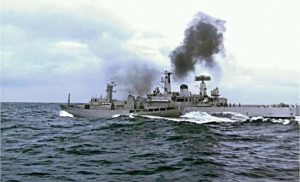 What started as minor disputes over fishing rights suddenly had implications for the Cold War. President Eisenhower…during the Proto Cod War…and Secretary of State Henry Kissinger…during the Second Cod War…talked about the Icelanders in terms of the “tyranny of the weak,” as they felt compelled to oblige their small, obstinate, strategically important ally. With NATO allies heaping pressure on the British. to settle and Icelandic politicians clearly constrained by public pressure, the British reluctantly gave in to most of the Icelanders’ demands. Iceland achieved favorable agreements in each Cod War, with the last Cod War concluding 40 years ago when the Icelanders achieved a 200-mile exclusive economic zone.
What started as minor disputes over fishing rights suddenly had implications for the Cold War. President Eisenhower…during the Proto Cod War…and Secretary of State Henry Kissinger…during the Second Cod War…talked about the Icelanders in terms of the “tyranny of the weak,” as they felt compelled to oblige their small, obstinate, strategically important ally. With NATO allies heaping pressure on the British. to settle and Icelandic politicians clearly constrained by public pressure, the British reluctantly gave in to most of the Icelanders’ demands. Iceland achieved favorable agreements in each Cod War, with the last Cod War concluding 40 years ago when the Icelanders achieved a 200-mile exclusive economic zone.
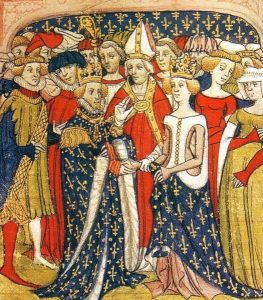 Most people think that English came from England, and of course, it did, however, in England prior to the 19th century, the English language was not spoken by the aristocracy, but rather only by “commoners.” Back then, English used to belong to the people, and I suppose that might explain some of the “incorrect” uses of the language which have been so severely attacked by contemporary English speakers. Prior to the 19th century, the aristocracy in English courts spoke French. This was due to the Norman Invasion of 1066 and caused years of division between the “gentlemen” who had adopted the Anglo-Norman French and those who only spoke English. Even the famed King Richard the Lionheart was actually primarily referred to in French, as Richard “Coeur de Lion.”
Most people think that English came from England, and of course, it did, however, in England prior to the 19th century, the English language was not spoken by the aristocracy, but rather only by “commoners.” Back then, English used to belong to the people, and I suppose that might explain some of the “incorrect” uses of the language which have been so severely attacked by contemporary English speakers. Prior to the 19th century, the aristocracy in English courts spoke French. This was due to the Norman Invasion of 1066 and caused years of division between the “gentlemen” who had adopted the Anglo-Norman French and those who only spoke English. Even the famed King Richard the Lionheart was actually primarily referred to in French, as Richard “Coeur de Lion.”
In my opinion, this dual language society would have caused numerous problems. The indication I get is that neither side could speak the language of the other, but I don’t know how a monarchy could rule, if the “commoners” could not understand the language and therefore the orders of the monarchy. French was spoken and learned by anyone in the upper 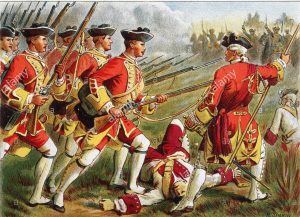 classes. However, it became less useful as English lost its control of various places in France, where the peasants spoke French, too. After that…about, 1450…English was simply more useful for talking to anybody. It is still true that British royals and many nobles are fluent in French, but they only use it to talk to French people, just like everybody else.
classes. However, it became less useful as English lost its control of various places in France, where the peasants spoke French, too. After that…about, 1450…English was simply more useful for talking to anybody. It is still true that British royals and many nobles are fluent in French, but they only use it to talk to French people, just like everybody else.
To further confuse your preconceptions about the English language, the “British accent” was, in reality, created after the Revolutionary War, meaning contemporary Americans sound more like the colonists and British soldiers of the 18th century than contemporary Brits. Many people have made a point of how much they love the British accent, but I think very few people know the real story behind the British accent. In the 18th century and before, the British “accent” was the way we speak herein America. Of course, accents vary greatly  by region, as we have seen with the accents of the south and east in the United States, but the “BBC English” or public school English accent…which sounds like the James Bond movies…didn’t come about until the 19th century and was originally adopted by people who wanted to sound fancier. I suppose it was like the aristocracy and the commoners, in that one group didn’t want to be mistaken for the other. After being handily defeated by the American colonists, I’m sure that the British were looking for a way to seem superior, even in defeat. The change in the accent of the English language was sufficient to make that distinction. Maybe it was their way of saying that they were better than the American guerilla-type soldiers who beat them in combat…basically they might have lost, but they were superior…even if it was only in how they sounded.
by region, as we have seen with the accents of the south and east in the United States, but the “BBC English” or public school English accent…which sounds like the James Bond movies…didn’t come about until the 19th century and was originally adopted by people who wanted to sound fancier. I suppose it was like the aristocracy and the commoners, in that one group didn’t want to be mistaken for the other. After being handily defeated by the American colonists, I’m sure that the British were looking for a way to seem superior, even in defeat. The change in the accent of the English language was sufficient to make that distinction. Maybe it was their way of saying that they were better than the American guerilla-type soldiers who beat them in combat…basically they might have lost, but they were superior…even if it was only in how they sounded.
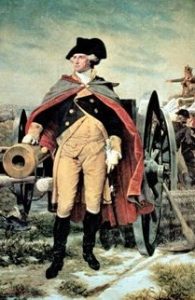
 How many Generals can say that a housewife saved their life? Not many, I’m sure. Most housewives would never get near enough to a general in combat to do anything, but in the 1700s, things were different. Of course, it wasn’t like Philadelphia housewife and nurse Lydia Darragh, got out there and fought along-side General Washington and his Continental Army, but she was, nevertheless, able to single-handedly save their lives when she overheard the British planning a surprise attack on Washington’s army for the following day. Some say this is just a legend, and I guess we will never know for sure, but the story has endured for 240 years, which says something to me.
How many Generals can say that a housewife saved their life? Not many, I’m sure. Most housewives would never get near enough to a general in combat to do anything, but in the 1700s, things were different. Of course, it wasn’t like Philadelphia housewife and nurse Lydia Darragh, got out there and fought along-side General Washington and his Continental Army, but she was, nevertheless, able to single-handedly save their lives when she overheard the British planning a surprise attack on Washington’s army for the following day. Some say this is just a legend, and I guess we will never know for sure, but the story has endured for 240 years, which says something to me.
This historic event happened on December 2, 1777, during the occupation of Philadelphia. British General William Howe had stationed his headquarters across the street from the Darragh home. When Howe’s headquarters proved too small to hold meetings, he commandeered a large upstairs room in the Darraghs’ house. Although uncorroborated, family legend holds that Mrs. Darragh used to eavesdrop and take notes on the British meetings from an adjoining room and would conceal the notes by sewing them into her coat before passing them onto American troops stationed outside the city. It was a critical mistake on the part of the British, and the ingenious way of passing the information worked very well for the patriots.
On the evening of December 2, 1777, Darragh overheard the British commanders planning a surprise attack on Washington’s army at Whitemarsh, Pennsylvania, for December 4th and 5th. Somehow, it completely amazes me that they would be so careless with the information, especially considering the fact that they were in the home of the enemy. I guess they assumed that the housewife would have no idea what the “great military minds” were thinking or talking about, nor that she would have any way to pass the information to anyone who could do anything about it. I’m sure they were completely shocked when they realized that she had tipped General Washington off to the plot, and saved the lies of him and his army…as well as saving the day.
Using a cover story that she needed to buy flour from a nearby mill just outside the British line, Darragh passed the information to American Lieutenant Colonel Thomas Craig the following day. The British marched towards Whitemarsh on the evening of December 4, 1777, and were surprised to find General Washington and 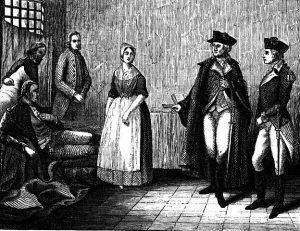
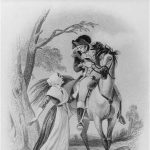 the Continental Army waiting for them. After three inconclusive days of skirmishing, General Howe chose to return his troops to Philadelphia. It’s an amazing victory for General Washington and his Continental Army, and it all happened because a patriot housewife turned spy for her country. When you think about it, she already had the perfect disguise for the job. It is said that members of the Central Intelligence Agency still tell the story of one of the first spies in American history.
the Continental Army waiting for them. After three inconclusive days of skirmishing, General Howe chose to return his troops to Philadelphia. It’s an amazing victory for General Washington and his Continental Army, and it all happened because a patriot housewife turned spy for her country. When you think about it, she already had the perfect disguise for the job. It is said that members of the Central Intelligence Agency still tell the story of one of the first spies in American history.
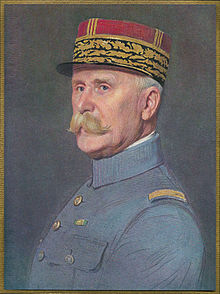
 Sometimes, when a war plane is in danger of being captured by the enemy, the pilot might take measures to destroy it, so that the technological secrets don’t end up in enemy hands. In fact, I believe that these days, anytime a plane goes down in enemy territory, the pilots are told to destroy them, but I’m not sure on that.
Sometimes, when a war plane is in danger of being captured by the enemy, the pilot might take measures to destroy it, so that the technological secrets don’t end up in enemy hands. In fact, I believe that these days, anytime a plane goes down in enemy territory, the pilots are told to destroy them, but I’m not sure on that.
Strange as that may seem to most of us, on November 27, 1942, something even more strange happened, but I’m getting ahead of myself. In June of 1940, after the German invasion of France and the establishment of an unoccupied zone in the southeast, which was led by General Philippe Petain, Admiral Jean Darlan was committed to keeping the French fleet out of German control. At the same time, as a minister in the government that had signed an armistice with the Germans, one that promised a relative “autonomy” to Vichy France, Darlan was prohibited from sailing that fleet to British or neutral waters. It put him in a rather precarious position, to say the least.
The British were as concerned as the French. A German-commandeered fleet in southern France, so close to British-controlled regions in North Africa, could prove disastrous to the British, who decided to take matters into their own hands by launching Operation Catapult…the attempt by a British naval force to persuade the French naval commander at Oran to either break the armistice and sail the French fleet out of the Germans’ grasp…or to scuttle it. And if the French wouldn’t, the Brits would. If you’ve ever heard the expression, “between a rock and a hard place,” you can picture this situation. And the British tried to push their way in it. In a five-minute missile bombardment, they managed to sink one French cruiser and two old battleships. They also killed 1,250 French sailors. This would be the source of much bad blood between France and England throughout the war. General Petain broke off diplomatic relations with Great Britain.
Two years later, the situation had worsened, with the Germans now in Vichy and the armistice already violated. Admiral Jean de Laborde finished the job the British had started. Just as the Germans launched Operation Lila…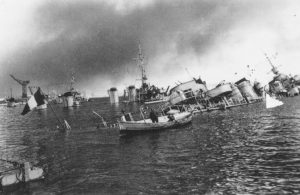
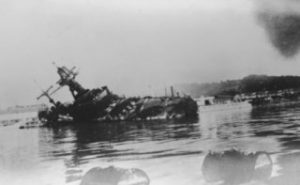 the attempt to commandeer the French fleet, at Toulon harbor, off the southern coast of France, Laborde ordered the sinking of 2 battle cruisers, 4 heavy cruisers, 2 light cruisers, 1 aircraft transport, 30 destroyers, and 16 submarines. Three French subs managed to escape the Germans and make it to Algiers, Allied territory. Only one sub fell into German hands. The marine equivalent of a scorched-earth policy had succeeded.
the attempt to commandeer the French fleet, at Toulon harbor, off the southern coast of France, Laborde ordered the sinking of 2 battle cruisers, 4 heavy cruisers, 2 light cruisers, 1 aircraft transport, 30 destroyers, and 16 submarines. Three French subs managed to escape the Germans and make it to Algiers, Allied territory. Only one sub fell into German hands. The marine equivalent of a scorched-earth policy had succeeded.
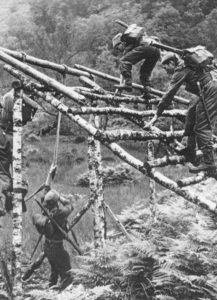
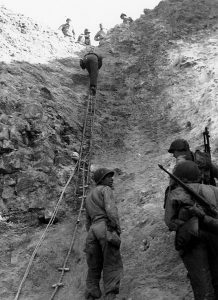 These days, everyone has heard of the special forces units and special ops, which is special operations. The main reasons we know about them are terrorism, and war in the current world. Special forces and special operations forces are military units trained to conduct the kinds of operations that are often much more dangerous than even the boots on the ground part of battle. NATO defines special operations as “military activities conducted by specially designated, organized, trained, and equipped forces, manned with selected personnel, using unconventional tactics, techniques, and modes of employment”. In other words, these are the guys who go into ugly situations in an effort to keep us safe. Of course, this, in no way, detracts from our first responders, who we all know are just as vital. There is just a difference in the scope of their jobs. The Special Forces emerged in the early 20th century, with a significant growth in the field during the World War II, when “every major army involved in the fighting” created formations devoted to special operations behind enemy lines. It was going to be the only way to win such a war.
These days, everyone has heard of the special forces units and special ops, which is special operations. The main reasons we know about them are terrorism, and war in the current world. Special forces and special operations forces are military units trained to conduct the kinds of operations that are often much more dangerous than even the boots on the ground part of battle. NATO defines special operations as “military activities conducted by specially designated, organized, trained, and equipped forces, manned with selected personnel, using unconventional tactics, techniques, and modes of employment”. In other words, these are the guys who go into ugly situations in an effort to keep us safe. Of course, this, in no way, detracts from our first responders, who we all know are just as vital. There is just a difference in the scope of their jobs. The Special Forces emerged in the early 20th century, with a significant growth in the field during the World War II, when “every major army involved in the fighting” created formations devoted to special operations behind enemy lines. It was going to be the only way to win such a war.
Special Forces teams perform some dangerous functions, including airborne operations, counter-insurgency, counter-terrorism, foreign internal defense, covert ops, direct action, hostage rescue, high-value targets/manhunting, intelligence operations, mobility operations, and unconventional warfare. In the United States, Special Forces refers to the US Army, Navy, Air Force, and Marine forces. The jobs of the Special Forces units are vital in today’s kind of warfare. Special Forces do reconnaissance and surveillance in hostile environments trying to make it safer to send in the troops. They are in charge of foreign internal defense…training and development of other states’ military and security forces, offensive action, support to counter-insurgency through population engagement and support counter-terrorism operations, sabotage, and demolition, as well as, hostage rescue. They are also used as body guards, in waterborne operations involving combat diving, combat swimming, maritime boarding and amphibious missions, as well as support of air force operations. Special forces have played an important role throughout the history of warfare, whenever the aim was to achieve disruption by “hit and run” and sabotage, rather than more traditional conventional combat. Other significant roles lay in reconnaissance, providing essential intelligence from near or among the enemy and increasingly in combating irregular forces, their infrastructure, and their activities. Originally there were separate units for the different branches of the military, but the need for interoperability between these units from the different services led to the formation US Special Operations Command (USSOCOM) in 1987. Our cousin Paul Noyes career in Special Operations was with Ranger, Special Forces and Aviation Special Ops forces, and he has become my military “go to” guy…letting me know if I hit the nail on the head or missed it.
For some reason, I thought Special Forces was, for the most part, a modern day unit, but that isn’t really true. Chinese strategist Jiang Ziya, in his Six Secret Teachings, described recruiting talented and motivated men into specialized elite units with functions such as commanding heights and making rapid long-distance advances. King David had a special forces platoon known as Gibborim. In Japan, ninjas were used for reconnaissance, espionage and as assassins, bodyguards or fortress guards, or otherwise fought alongside conventional soldiers. During the Napoleonic wars, rifle and sapper units were formed that held specialized roles in reconnaissance and skirmishing and were not committed to the formal battle lines. The British Indian Army 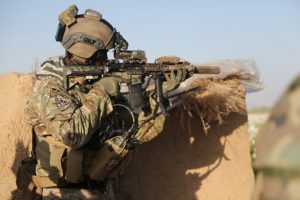
 deployed two special forces during their border wars…the Corps of Guides formed in 1846 and the Gurkha Scouts…a force that was formed in the 1890s and was first used as a detached unit during the 1897–1898 Tirah Campaign. I guess that the Special Forces units are long standing, expertly trained groups of very special people, who have achieved a level of expertise that is second to none, and I for one, and thankful that such soldiers exist.
deployed two special forces during their border wars…the Corps of Guides formed in 1846 and the Gurkha Scouts…a force that was formed in the 1890s and was first used as a detached unit during the 1897–1898 Tirah Campaign. I guess that the Special Forces units are long standing, expertly trained groups of very special people, who have achieved a level of expertise that is second to none, and I for one, and thankful that such soldiers exist.
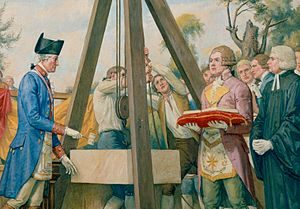
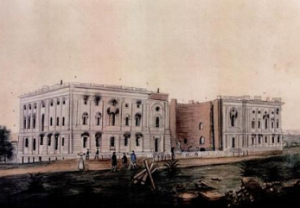 Most people know what the United States Capitol building looks like, and many have seen it, and even been inside it, but I wonder how many people know that is almost wasn’t completed. Yes, you heard me right. I almost wasn’t completed. As a young nation, the United States had no permanent capitol, and Congress met in eight different cities, including Baltimore, New York and Philadelphia, before 1791. In 1790, Congress passed the Residence Act, which gave President Washington the power to select a permanent home for the federal government. The following year, he chose what would become the District of Columbia from land that had been provided by Maryland. Washington picked three commissioners to oversee the capital city’s development and they in turn chose French engineer Pierre Charles L’Enfant to come up with the design. However, L’Enfant clashed with the commissioners and was fired in 1792. A design competition was held, and a Scotsman named William Thornton submitted the winning entry.
Most people know what the United States Capitol building looks like, and many have seen it, and even been inside it, but I wonder how many people know that is almost wasn’t completed. Yes, you heard me right. I almost wasn’t completed. As a young nation, the United States had no permanent capitol, and Congress met in eight different cities, including Baltimore, New York and Philadelphia, before 1791. In 1790, Congress passed the Residence Act, which gave President Washington the power to select a permanent home for the federal government. The following year, he chose what would become the District of Columbia from land that had been provided by Maryland. Washington picked three commissioners to oversee the capital city’s development and they in turn chose French engineer Pierre Charles L’Enfant to come up with the design. However, L’Enfant clashed with the commissioners and was fired in 1792. A design competition was held, and a Scotsman named William Thornton submitted the winning entry.
Then, on this day, September 18, 1793, Washington laid the Capitol’s cornerstone and the lengthy construction process, which would involve a line of project managers and architects, got under way. One would think that is due time, the capitol building would be finished, but in reality, it took almost a century to finish…almost 100 years!! During those years, architects came and went, the British set it on fire, and it was called into use during the Civil War. In 1800, Congress moved into the Capitol’s north wing. In 1807, the House of Representatives moved into the building’s south wing, which was finally finished in 1811. During the War of 1812, the British invaded Washington DC. They set fire to the Capitol on August 24, 1814. Thankfully, a rainstorm saved the building from total destruction. Congress met in nearby temporary quarters from 1815 to 1819. In the early 1850s, work began to expand the Capitol to accommodate the growing number of Congressmen. The Civil War halted construction in 1861 while the Capitol was used by Union troops as a hospital and barracks. Following the war, expansions and modern upgrades to the building continued into the next century.
Today, the Capitol building, with its famous cast-iron dome and important collection of American art, is part of the Capitol Complex, which includes six Congressional office buildings and three Library of Congress buildings, all developed in the 19th and 20th centuries. The Capitol, which is visited by 3 million to 5 million people each 
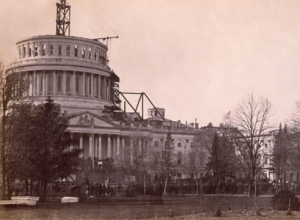 year, has 540 rooms and covers a ground area of about four acres. I’m sure that those who visit the United States Capitol Building probably hear all about it strange past and its construction history, but maybe not. I suppose that it depends on what the tour guide finds interesting. Personally, I like the unusual construction. Thankfully, the United States Capitol did finally get built and has become the beautiful building we know today.
year, has 540 rooms and covers a ground area of about four acres. I’m sure that those who visit the United States Capitol Building probably hear all about it strange past and its construction history, but maybe not. I suppose that it depends on what the tour guide finds interesting. Personally, I like the unusual construction. Thankfully, the United States Capitol did finally get built and has become the beautiful building we know today.
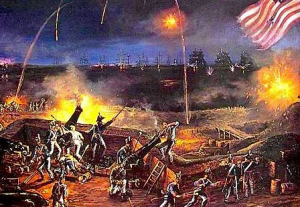 When I think of Independence Day, I often think about how the fireworks remind me of the many battles that went on in order to win our freedom. Then, I began to wonder if there was ever a time when the 13 colonies almost didn’t become the United States. Britain was, after all, the world’s greatest superpower at the time. British soldiers fought on 5 continents and they had an amazing navy. They massacred rebels and civilians in Jamaica and India around the same time and retained those colonies. So, why not the 13 colonies of North America? There are many explanations, but the one I found most interesting seems, almost to tie to the way things are in America right now…and really all along.
When I think of Independence Day, I often think about how the fireworks remind me of the many battles that went on in order to win our freedom. Then, I began to wonder if there was ever a time when the 13 colonies almost didn’t become the United States. Britain was, after all, the world’s greatest superpower at the time. British soldiers fought on 5 continents and they had an amazing navy. They massacred rebels and civilians in Jamaica and India around the same time and retained those colonies. So, why not the 13 colonies of North America? There are many explanations, but the one I found most interesting seems, almost to tie to the way things are in America right now…and really all along.
The reality is that Britain won many times on the battlefield, but…lost in the taverns. The taverns, you say. How  could that be? Well, taverns were everywhere. They were the social network of colonial life, much like the town hall meetings, and even more, like Facebook or Twitter today. Some areas of Massachusetts and Pennsylvania had taverns every few miles. People could get their mail there, hire a worker, talk to friends, sell crops, buy land, and eat a good meal. It was in these places that opinions were formed. People discussed the problems they had with British rule, and talked about how to get rid of the yoke of the Mother country.
could that be? Well, taverns were everywhere. They were the social network of colonial life, much like the town hall meetings, and even more, like Facebook or Twitter today. Some areas of Massachusetts and Pennsylvania had taverns every few miles. People could get their mail there, hire a worker, talk to friends, sell crops, buy land, and eat a good meal. It was in these places that opinions were formed. People discussed the problems they had with British rule, and talked about how to get rid of the yoke of the Mother country.
Some say that Britain might have had a chance if they had been represented in the taverns too, but I don’t think so. The time had come for Americans to think for themselves, and to run their own lives and their own country. First came the Stamp Act and the Americans protested. More oppression followed, as did the protests.  The resistance grew and grew, until war broke out. No matter what it took, the colonies were determined not to lose. The tavern meetings had accomplished what they needed to. No matter how many times it looked like Britain might win, they would not, because of…well, social networking. Social networking, when people get together to discuss right from wrong, and to discuss solutions. Sometimes the solutions are simple, and other times they create enough of a stir to bring about a revolution. No matter what the reason, the colonies were not about to lose, and because of that, we are a free nation and it was on this day, July 4, 1776 that our independence was made a reality, and we became the land of the free and the home of the brave. Happy Independence Day America!!
The resistance grew and grew, until war broke out. No matter what it took, the colonies were determined not to lose. The tavern meetings had accomplished what they needed to. No matter how many times it looked like Britain might win, they would not, because of…well, social networking. Social networking, when people get together to discuss right from wrong, and to discuss solutions. Sometimes the solutions are simple, and other times they create enough of a stir to bring about a revolution. No matter what the reason, the colonies were not about to lose, and because of that, we are a free nation and it was on this day, July 4, 1776 that our independence was made a reality, and we became the land of the free and the home of the brave. Happy Independence Day America!!
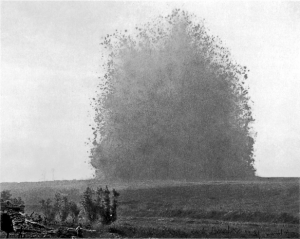 The manner in which battles are fought and won, never ceases to amaze me. In 1916, British forces began planning the Battle of Messines Ridge. For 18 months, soldiers worked to place nearly 1 million pounds of explosives in tunnels under the German positions. The tunnels extended to some 2,000 feet in length, and some were as much as 100 feet below the surface of the ridge, where the Germans had long since been entrenched. The Germans had no idea that they were there, and no idea what was going to happen. I find myself in complete amazement, that all those soldiers were working a mere 100 feet below ground, and the German soldiers above them had no idea. It was the element of surprise that was the whole key to this successful attack.
The manner in which battles are fought and won, never ceases to amaze me. In 1916, British forces began planning the Battle of Messines Ridge. For 18 months, soldiers worked to place nearly 1 million pounds of explosives in tunnels under the German positions. The tunnels extended to some 2,000 feet in length, and some were as much as 100 feet below the surface of the ridge, where the Germans had long since been entrenched. The Germans had no idea that they were there, and no idea what was going to happen. I find myself in complete amazement, that all those soldiers were working a mere 100 feet below ground, and the German soldiers above them had no idea. It was the element of surprise that was the whole key to this successful attack.
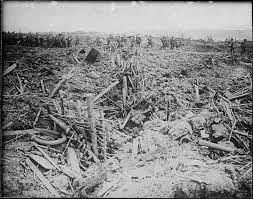 At 3:10am on June 7, 1917, a series of simultaneous explosions rocked the area. The explosions were heard as far away as London. A German observer described the explosions saying, “nineteen gigantic roses with carmine petals, or enormous mushrooms, rose up slowly and majestically out of the ground and then split into pieces with a mighty roar, sending up multi-colored columns of flame mixed with a mass of earth and splinters high in the sky.” While Messines Ridge itself was considered a relatively limited victory, it had a considerable effect. German losses that day included more than 10,000 men who died instantly, along with some 7,000 prisoners…men who were too stunned and disoriented by the explosions to resist the infantry assault.
At 3:10am on June 7, 1917, a series of simultaneous explosions rocked the area. The explosions were heard as far away as London. A German observer described the explosions saying, “nineteen gigantic roses with carmine petals, or enormous mushrooms, rose up slowly and majestically out of the ground and then split into pieces with a mighty roar, sending up multi-colored columns of flame mixed with a mass of earth and splinters high in the sky.” While Messines Ridge itself was considered a relatively limited victory, it had a considerable effect. German losses that day included more than 10,000 men who died instantly, along with some 7,000 prisoners…men who were too stunned and disoriented by the explosions to resist the infantry assault.
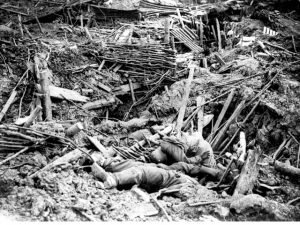
It was a crushing victory over the Germans. The German army was forced to retreat to the east. This retreat and the sacrifice that it entailed marked the beginning of their gradual, but continuous loss of territory along the Western Front. It also secured the right flank of the British army’s push towards the much-contested Ypres region, which was the eventual objective of the planned attack. Over the next month and a half, British forces continued to push the Germans back toward the high ridge at Passchendaele. Then on July 31 the British army launched it’s offensive, known as the Battle of Passchendaele or the Third Battle of Ypres.

